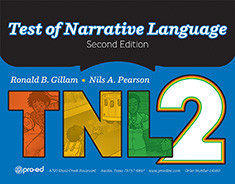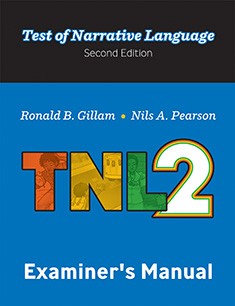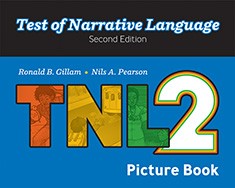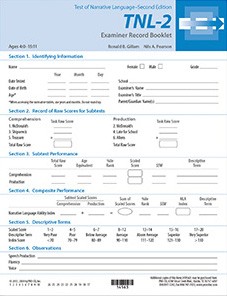Test of Narrative Language (TNL-2)
Complete Kit
Second Edition
- Ages 5 - 15
- Testing Time 15 - 20 minutes
- Administration Individual
- Copyright 2017
-
Product Code 14560 ( MR #066144 )
* Qualifications required to purchase this item. Click here to complete the qualifications form.
Price $239.00
Contents
The Test of Narrative Language–Second Edition (TNL-2) is a norm-referenced test that measures children’s narrative language abilities (i.e., children’s ability to understand and tell stories). Narration is an important aspect of spoken language, not usually measured by oral-language tests, that provides a critical foundation for literacy.
The TNL-2 enables clinicians to assess important aspects of narrative language without having to transcribe children’s stories. This saves hours of transcription time, and provides a valid and reliable metric of narrative language development. The TNL-2 is a natural complement to other standardized tests that use contrived formats to assess components of oral language, and it is especially useful for diagnosing language-based learning disabilities.
Features of the TNL-2
The TNL-2 is:
- a functional assessment of narrative comprehension and narrative production;
- a dynamic assessment in which comprehension and production tasks are alternated so children have the opportunity to profit from adult narrative models;
- a measure of the ability to comprehend and produce three types of stories: a script, a personal narrative, and a fictional narrative;
- a system for scoring oral narratives that does not require clinicians to transcribe the stories;
- a normative test with clear, well-organized norms tables and administration procedures, as well as an easy-to-use record form; and
- a fair and equitable assessment of narrative discourse for all children.
Improvements in the TNL-2
The test has been improved in three major ways:
- New, more colorful pictures.
- More inferential comprehension questions.
- A consistent scoring format.
Additional improvements to the test, based on feedback and current research, include:
- The normative sample is larger than the sample for the original TNL, with a wider age range (4–15 for the TNL-2 as compared to 5–12 for the TNL) and many more children at each age.
- The norms are based on new standardization data that were collected between 2013 and 2015. The demographic characteristics of the sample conform to those of the population reported by the U.S. Census Bureau and are representative of the U.S. population.
- The McDonald’s story retelling now has a picture that supports it, so that all the comprehension and production tasks have the same visual support.
- The pictures were revised to make them more colorful and interesting to children.
- The number of items on the comprehension tasks was increased, with more inferential items; more items for the youngest, low-functioning examinees; and more items for the oldest, high-functioning examinees.
- The scoring system for the oral narratives is now similar across the three types of stories. These changes make the TNL easier to score and more reliable.
- The reliability and validity chapters have been expanded.
- Numerous studies that provide evidence of the test’s construct validity and its long-term stability have been added to the validity chapter.
- A study of the test’s diagnostic accuracy (sensitivity and specificity) supports its use for diagnosing children with language impairment and language-based learning disabilities that affect reading and writing.
No additional information available for this item.

 Proud to be Canadian
Proud to be Canadian


